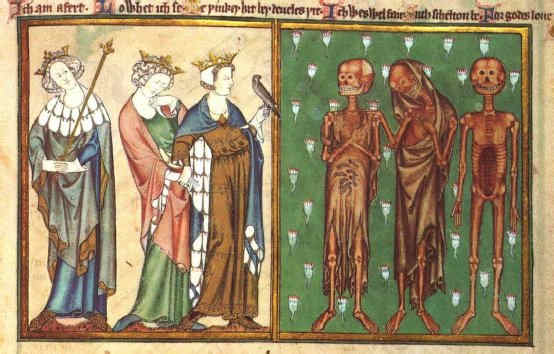Death Personified: History and Depictions of the Grim Reaper
Origins of the Grim Reaper
For most, if not all of us, the words "Grim Reaper" bring to mind a very specific image. We have all seen it: a silent, towering, dark-robed, skeletal figure holding a scythe. It is most commonly depicted standing over a dying person or in a graveyard. We know almost instinctively that it is a symbol of death or impending death.
But what do we really know about the mysterious Reaper? Where did this figure come from? No one would be surprised to discover that the idea of the Grim Reaper has its origins in death itself, but you may be surprised to learn that the first imagery of death personified stems all the way back to the 13th century.

Illustration from the "De Lisle Psalter" manuscript (1308–1320), depicting the Three Living and the Three Dead
According to Dr. Emily Zarka, one of the first images of skeletal figures depicting death comes from the late 13th century and is based on a story from that same time period about the "Three Living and the Three Dead." In the story, three men out hunting encounter three skeletal figures that teach them a lesson about the value and shortness of life.
In the 14th century, the bubonic plague, also known as the Black Death, swept Europe from 1347 to 1352. Death was everywhere, claiming an estimated 25 million lives during this time, although some sources estimate millions more. We now know that the plague was spread through bites from infected rats and fleas, which were pervasive during that time, and even through the very air people breathed.
In medieval times, it was believed by many that the plague was a punishment from God because of how quickly it spread and how many it killed.
Danse Macabre
The prominence of death and decay plaguing the 14th century inspired what is known as Danse Macabre, a movement in medieval artwork that depicted skeletons dancing the living away to their death. It was a beautiful allegory for mortality and death as the greatest equalizer. After all, regardless of wealth or status, everyone dies.
During and after the Black Death, images of death as a singular entity also began to arise. It only makes sense that during such a distressing time, we would want to give a face to, make light of, and even come to accept the fact that death is just a part of life.
Where the Grim Reaper Name Comes From
The image of death holding various weapons was not uncommon. However, the popularization of death holding a scythe also began during the plague because the scythe was a common crop harvesting tool at the time. A tool that cut down and harvested crops seemed the most appropriate for an entity that essentially harvested living souls from the Earth.
"Reaper" was originally a term used to describe someone who harvested crops with a sickle, while someone who harvested using a scythe was called a mower. It seems that since both terms and tools are strongly connected to the harvest, they became melded together to create the image and name of the harvester of souls. The result was the scythe-wielding Reaper we know today.
Using the word "grim" to describe the Reaper is completely understandable. Death isn't exactly a happy subject. However, the first recorded usage of the term "grim reaper" did not actually appear until 1847 in the book The Circle of Human Life, originally written in German by August Tholuck and translated to English by Reverend Robert Menzies. The book reflects on the stages of a Christian life from birth to death. Menzies' translation states:
All know full well that life cannot last above seventy, or at the most eighty years. If we reach that term without meeting the grim reaper with his scythe, there or there about, meet him we surely shall. Death being thus the most certain of all certain events, why not begin at once the work of preparation for it?
The term clearly stuck and has become probably the most common phrase used to describe the personification of death. That being said, every culture has its own depictions of death, and the closest influences on the Grim Reaper as we know it come from Greek mythology.

"Chronos" by Giovanni Francesco Romanelli
Giovanni Francesco Romanelli, public domain, via Wikimedia Commons
Recommended
Representations of Death in Greek Mythology
Depending on the culture, death has been depicted as a male or female. Some belief systems even include multiple gods that represent different kinds of death. A good example of this is in Greek mythology.
Thanatos
The well-known Greek god Thanatos was a calm god who gently carried souls to the Underworld when their fate expired. Thanatos is believed to be one of the primary inspirations for the Reaper we envision today.
The Keres
Thanatos' sisters, known as the Keres, were more violent and bloodthirsty personifications of death, imagined to rip the souls of the mortally wounded from their bodies.
Chronos and Cronus
Chronos, the Greek god of time, and Cronus, a Titan in Greek mythology who was associated with the harvest and depicted holding a sickle, were often thought of as different versions of the same figure. Their associations are very appropriate when we think about time, the harvest, and the cycle of life.
You can see how these Greek figures may have influenced the more modern personifications of death. The Reaper is known for quietly leading the souls of the dead into the afterlife, harvesting them from the earth. He is also sometimes depicted holding an hourglass to remind us of our remaining time to live and how it will eventually run out.
Depictions of Death in Different Cultures
Every culture has its own depiction or specific imagery of death. A lot of these depictions are of gods who warn of death or guide the dead in the afterlife.
Hel
Another example of death portrayed as a female is the Norse goddess Hel. Hel is responsible for ruling over Helheim, the realm of the dead. As a keeper of the dead, she is known for being cold and serious but ultimately neutral.
Anubis
The jackal-headed Egyptian god Anubis took on more of a caregiver role, embalming, protecting, and guiding the dead. He is often shown holding a rod with three strands, called a flail. It is believed that Ancient Egyptians used flails to defend sheep from predators and thieves, and in their artwork the flail is often combined with a shepherd's crook—a kind of staff that may remind us of the Reaper's scythe.
Yama
The Hindu god Yama is considered to be the first human to ever die, and thus now leads others after death. Yama has the final say in what happens to souls after death (a form of judgment), and he is usually depicted with blue or green skin, riding a buffalo and carrying a rod and noose for catching souls.
Banshees
While perhaps not a personification, the banshees of Celtic lore shriek to warn of impending death. In her book Ancient Legends, Mystic Charms, and Superstitions of Ireland, Jane Wilde writes, "Sometimes the Banshee assumes the form of some sweet singing virgin of the family who died young, and has been given the mission by the invisible powers to become the harbinger of coming doom to her mortal kindred."
These are just a few of the many shapes that death or its harbingers can take around the world.
Portrayals of the Grim Reaper in Popular Culture
Whether it be music, horror movies, or TV shows, the Grim Reaper has become an iconic figure in pop culture. A version of Death appears as a character in many TV shows such as Family Guy, Charmed, and Dead Like Me. There is also the classic story A Christmas Carol, which has many movie adaptations and depicts a figure closely resembling the Grim Reaper: the Ghost of Christmas Yet to Come.
Here are a few of my favorite examples of the Reaper in pop culture.
"(Don't Fear) the Reaper" (Song) by Blue Öyster Cult
Released in 1976, "(Don't Fear) the Reaper" is a song by American rock band Blue Öyster Cult. The guitarist and singer Donald Roeser (Buck Dharma) wrote the song about finding courage in the face of death and accepting it as a part of our journey.







